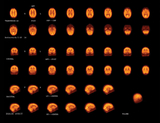Brain Scan
What is a brain scan?

A brain scan is a test that evaluates brain function and can also be used to detect seizure* disorders.
We do the test by giving your child an intravenous radiopharmaceutical. This "tracer" is medicine combined with a small amount of radioactive material. The radioactive material travels to the part of your child's body we need to see and is detected and imaged by a gamma camera.
Radiopharmaceuticals are carefully tested. The risk of side effects is extremely small. Most radiopharmaceuticals used in nuclear medicine studies give less radiation exposure than a day at the beach.
*If your child is part of the seizure protocol study then he will be admitted as an inpatient by the neurology team and instructions, appointment times and any other information you may need will be given by neurology.
What should you do prior to your child's exam?
- Your child will have to hold still during the test, which takes about an hour. You may want to practice with your child.
- If your child requires sedation you will receive additional instructions to follow.
- Dress your child comfortably, in clothes that are easily removed. Your child may be given a gown to change into for the procedure.
- You may want to bring a snack or drink for your child to have after the exam.
Note: Parents will be allowed to accompany the child into the exam room. It may be helpful to make other arrangements for siblings.
What should you expect during the exam?
- A technologist or nurse will place an IV in your child’s arm, hand or foot. Your child may feel a small pinch.
- The technologist will ask why the brain scan is being done, and explain the study to you and your child. The technologist will inject the tracer through the IV line. The tracer emits radiation that is detected by a gamma camera. Gamma cameras do not produce radiation or cause harm. They detect and image radiation.
- Imaging will begin anywhere from 30 minutes up to four hours after your child is given the tracer injection. The technologist will tell you and your child what to do while waiting.
- During the imaging portion of the test, we use a specialized holder to help keep your child's head still. This exam is performed using SPECT imaging. The camera will be brought in very close to the head and will slowly rotate around your child. After viewing the initial images, the nuclear medicine physician may want to take more.
Young patients and those who are unable to hold still may be sedated for the test.
If you’d like, our child life specialists will help you prepare and support your child during the procedure. We can also arrange to have a child life specialist at your child's appointment to explain the procedure in developmentally appropriate ways and to help your child better cope with the stress of the hospital experience.
What should you do after the exam?
There are no special instructions for your child to follow after the procedure.
Test results
The images from your child's exam are interpreted on the same day and a report is sent to your physician's office.
Your physician may call 215-590-2584 with questions about the exam.
Here is an example of what your child's exam may look like.